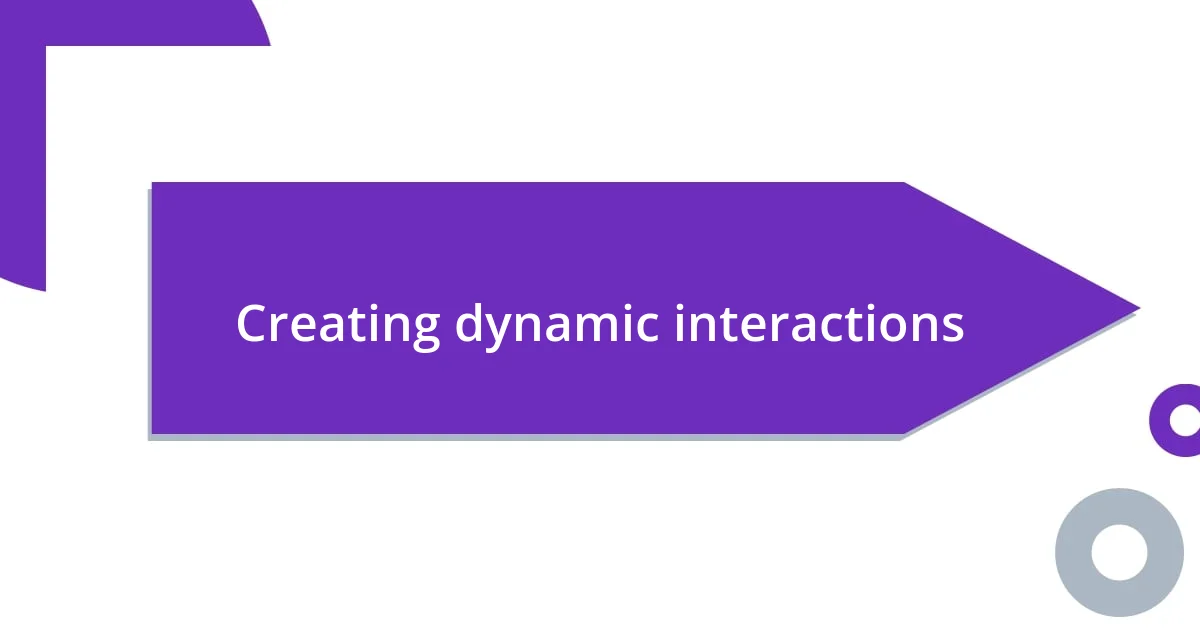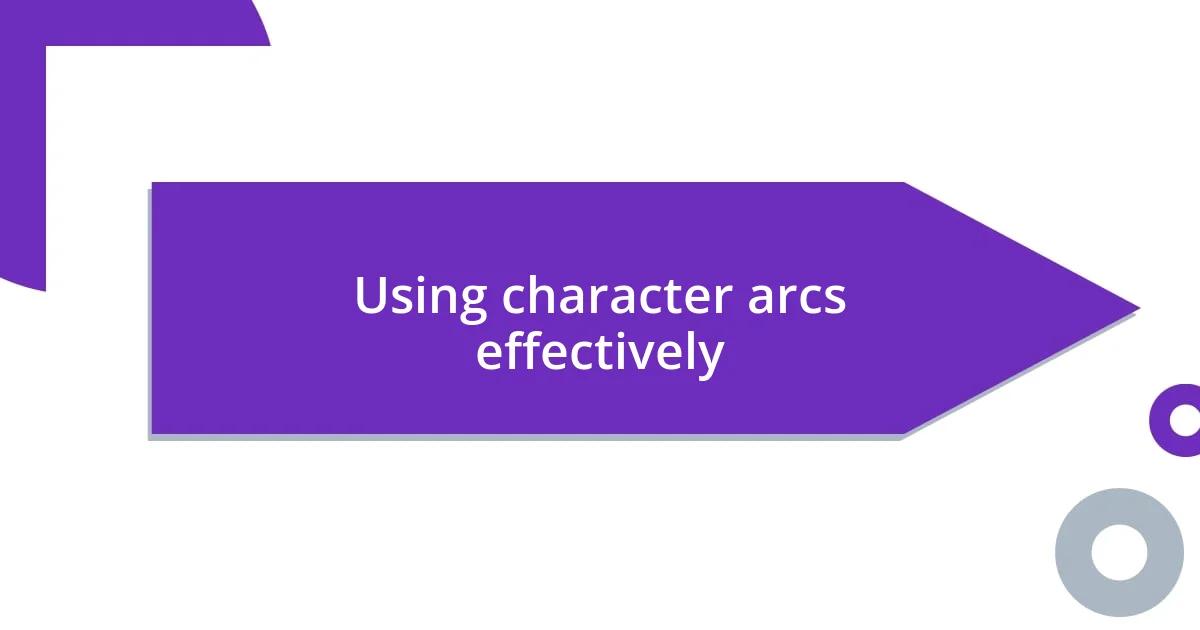Key takeaways:
- Character relationships should reflect shared histories, vulnerabilities, and emotional struggles to resonate with readers.
- Dynamic interactions are created through conflict, empathy, and character growth, showcasing the complexities of human connections.
- Revising relationships for deeper emotional currents and subtle gestures can enhance character depth and reader engagement.

Understanding character relationships
Understanding character relationships is essential for creating authentic narratives. I remember feeling so invested in my characters’ dynamics, especially when I noticed how their past experiences shaped their interactions. Have you ever thought about how two characters can reflect one another’s strengths and weaknesses? This mirroring can add depth and realism to their bond.
One of the most enlightening moments for me came while developing a sibling relationship in my story. I realized that siblings often pull from a shared history filled with both love and rivalry. This complexity can be a powerful driver of conflict and resolution, enabling readers to connect with the characters on a deeper emotional level. How does your own history influence your relationships, and can that translate into your writing?
As I explored romantic relationships in my work, I found that vulnerability is crucial. I crafted scenes where my characters faced their fears—revealing insecurities and desires. It struck me that readers are drawn to authenticity, so I tried to weave in moments that reflected real-life emotional struggles. Have you considered how these heartfelt exchanges can transform your characters and resonate with your audience?

Developing character backstories
Developing character backstories is one of the most rewarding aspects of writing for me. I often find myself daydreaming about my characters’ pasts, almost as if they were real people. When I wrote about a character who had grown up in a strict household, I tapped into my own experiences. I recalled how pressure can shape choices and emotions. This exploration not only enriched my character’s personality but also made their current struggles feel authentic and relatable.
In another instance, I created a character whose upbringing was filled with uncertainty and instability. By delving into the emotional scars left by her past, I was able to highlight her reluctance to trust others. Crafting her backstory required me to reflect on the fragility of relationships. It made me realize that vulnerability often stems from unresolved issues, and I aimed to weave this into her interactions. Have you ever noticed how a character’s past can completely alter their present and drive their decisions?
I believe that a well-developed backstory can resonate beyond the pages. When I introduce a character’s fears or regrets, I try to think about how those moments shape their relationships with others. For example, a character haunted by a childhood trauma may find it difficult to open up in romantic situations. This connection can evoke empathy and understanding in the readers, reminding them of the intricate tapestry of human experiences.
| Character Backstory Element | Impact on Character Relationships |
|---|---|
| Childhood Experiences | Shapes trust and communication styles |
| Family Dynamics | Influences loyalty and conflict |
| Past Trauma | Affects vulnerability and intimacy |
| Significant Life Events | Drives motivation and decisions |

Creating dynamic interactions
Creating dynamic interactions truly depends on the complexities written into character relationships. I recall a scene where two characters, who seemed like opposites on the surface, found common ground in their shared experiences of loss. That moment not only shocked me as a writer but also revealed how contrasting personalities can create riveting exchanges filled with tension and empathy. It’s as if their differences spark a unique dance, leading them to unexpected revelations about themselves and each other.
Here are some key elements I focus on to bring those interactions to life:
- Conflict: Contradicting goals can heighten tensions, compelling characters to confront one another.
- Empathy: Sharing vulnerabilities allows characters to connect on a deeper emotional level, fostering genuine relationships.
- Humor: Light-hearted banter can diffuse intense situations and showcase rapport, making characters relatable.
- Growth: Characters changing because of their relationships elevates the narrative, reflecting real-life dynamics.
- Miscommunication: Distorted perceptions often lead to misunderstandings and can serve as both a catalyst for drama and a pathway to resolution.
By embracing these elements, I’ve witnessed how character interactions can evolve, transforming not only the narrative but also my understanding of what it means to connect with others.

Balancing conflict and resolution
Balancing conflict and resolution in storytelling is an art. I often find myself at a crossroads, wondering how much conflict is necessary before a resolution feels earned. For instance, when two of my characters engaged in a heated argument over a fundamental difference in values, I realized the tension created a powerful moment of reflection. It pushed them—and me—to explore not just their disagreements but also the underlying fears that fueled those conflicts.
Taking that same narrative further, I’ve learned that resolution doesn’t always mean tying everything up neatly. One time, I wrote a scene where a character had to confront the repercussions of a hurtful decision, and rather than a clean wrap-up, I allowed the emotional fallout to linger. It highlighted the reality that resolution often involves ongoing struggles, a messy path that mirrors our own experiences. Doesn’t life often work that way, where conflicts occasionally resurface, requiring us to navigate our feelings anew?
There’s something deeply resonant about characters grappling with both conflict and resolution side by side. I remember creating a situation where a character had to let go of her anger to mend a friendship. The vulnerability she displayed not only moved me but also underscored the importance of emotional honesty in healing relationships. Wouldn’t you agree that the tension between unresolved issues and the desire for connection drives us, both in life and through the characters we write?

Crafting meaningful dialogue
Crafting meaningful dialogue is like weaving a thread through the fabric of character relationships. I once had a character stammer through an apology, their voice cracking with vulnerability. In that moment, I realized how powerful honesty can be; it transformed a simple exchange into a cathartic experience for both characters, and even for me as the writer. The hesitation and emotion in their words conveyed more than just the apology itself—it showcased their growth and fear of losing connection.
When I write dialogue, I often think about rhythm and silence. In one scene, I had two friends sitting in silence after a heated argument, their unspoken words more profound than anything they could articulate. The weight of that quiet tension made the eventual release of their emotions feel even more significant. Isn’t it fascinating how sometimes the pauses can speak volumes about what characters truly feel?
I also focus on the unique voices of my characters to create authenticity. Each one has their quirks, catchphrases, and even their own rhythm of speech. I remember crafting a character who inserted humor into tense situations with a perfect one-liner that instantly lightened the mood. Their ability to bring laughter amid chaos not only deepened their friendship but also provided a valuable insight—how humor can be a crucial coping mechanism, allowing us to navigate the complexities of human interaction. Don’t you think dialogue has the power to reveal so much about who we are, both in fiction and real life?

Using character arcs effectively
Using character arcs effectively can truly elevate a story, transforming a simple narrative into a journey of growth. I remember when I transformed a character from a self-centered individual into someone capable of empathy. It wasn’t just about their actions changing; I crafted moments that allowed readers to witness the internal struggles that drove this evolution. I find that it’s those small, incremental changes—the subtle shifts in perspective—that make character arcs resonate deeply.
There’s an elegance in knitting together the character’s experiences with their growth. For instance, I incorporated a defining moment where my character had to choose between personal gain or helping a friend in distress. It was a pivotal choice that tugged at their heart and instincts, forging a bond with the reader. It’s almost like asking, “What would I do in that situation?” Those dilemmas not only enrich the character but also invite readers to reflect on their values—don’t you love when fiction feels like a mirror, reflecting our own choices?
What I’ve also learned is that character arcs don’t exist in isolation; they interact dynamically with other characters, influencing and amplifying growth. I think of a subplot where my character’s mentor challenged them to confront their fears. Their relationship was a dance of vulnerability and guidance, showcasing that growth often happens in community. How does that resonate with you? After all, aren’t our relationships instrumental in shaping who we are? I believe that weaving interconnected character arcs adds a layer of authenticity and depth, enriching the reader’s experience immensely.

Revising relationships for impact
Revising relationships can be a game-changer in my writing process. I vividly recall a moment when I had to rework a friendship that initially felt one-dimensional. I decided to dive deeper into their shared past, crafting a scene from childhood where a betrayal had once planted seeds of distrust. It was in that moment of reflection that I realized how crucial history is in shaping character dynamics; it transformed their interactions and added a layer of tension that made the reader root for their reconciliation. Don’t you think that understanding a character’s past enriches their present relationships?
As I revise, I often focus on the emotional undercurrents that run between characters. For example, in one scenario, I had two sisters whose bond was strained by jealousy. By revisiting and expanding their arguments to include shared dreams and disappointments, I found a way to highlight their vulnerability, making their journey toward understanding much more impactful. That emotional complexity can elevate a narrative, don’t you agree? It’s those messy, authentic feelings that draw readers into the story.
I’ve learned that subtle gestures can reveal so much about a relationship. During revisions, I added a simple touch—one character brushing the other’s arm to comfort them during a moment of despair. This minor detail amplified their connection, making their bond feel tangible and real. Isn’t it intriguing how a small action can hold so much weight? I find that these little moments often resonate the most with readers, leaving them with lasting impressions of the characters long after the story ends.














